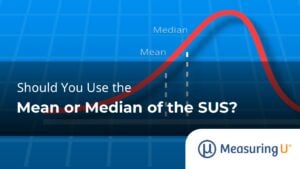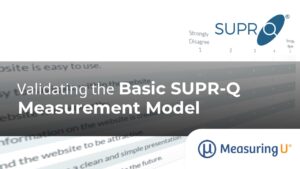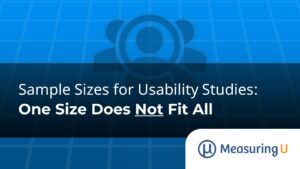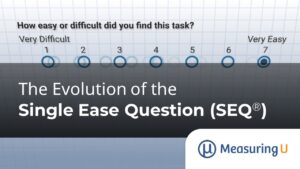Topics
Topics

Building a Website Clutter Questionnaire
Clutter, clutter everywhere, nor any questionnaire to measure. In a previous article, we described our search for a measure of perceived clutter in academic literature and web posts, but we were left unquenched. We found that the everyday conception of clutter includes two components that suggest different decluttering strategies: the extent to which needed objects

Should You Use the Mean or Median of the SUS?
Since its development in the 1980s, System Usability Scale (SUS) score analysis has focused on estimating and comparing means. The mean is one type of average. Would it be more appropriate to estimate and compare SUS medians instead of means? To investigate this question, we analyzed and compared SUS means and medians collected from over

What You Get with Specific Sample Sizes in UX Problem Discovery Studies
What sample size should you use for a problem discovery (formative) usability study? In practice, the answer is based on both statistics AND logistics. A statistical formula will tell you an optimal number to select. But the real-world logistical constraints of budgets, recruiting challenges, and time will often dictate the maximum number of participants you

Validating the Basic SUPR-Q Measurement Model
What makes a measure valid? Good intentions? Because someone influential said to use it online? A measure is valid if it can be demonstrated that it measures what it is intended to measure, has the expected alignment of items with factors, and has the expected statistical relationships with other metrics. Its usage also depends on

The UX of Social Media in 2024
Professions, politics, and pop culture. Social media reflects and affects where we work, who we vote for, what we purchase, and what we do in our free time. Since we last examined the social media space in 2018, social media has deviated from its original photo-sharing roots to incorporate short-form video, AI, gaming, dating, and

Sample Sizes for Usability Studies: One Size Does Not Fit All
“How many participants should you run in a usability study?” How many times have you heard that question? How many different answers have you heard? After you sift through the non-helpful ones, probably the most common answer you’ve heard is five. You might have also heard that these “magic 5” users can uncover 85% of

In Search of a Clutter Metric for Websites
A disorganized closet. A messy bedroom. Clutter can make a space feel stressful and make it hard to find things. But it’s not just your mother talking about clutter. We often use the same language to describe digital spaces like websites. In our UX research practice, we have frequently encountered users and designers criticizing website

12 Things to Know About Using the TAC-10 to Measure Tech Savviness
How do you measure tech savviness? UX researchers are, of course, not in the business of assessing individual performance. But differences in individual technical abilities certainly have an impact on performance. A good measure of tech savviness can help researchers target levels of tech savviness in recruiting (e.g., low, high, or a mix) and classify

Is the UX-Lite Predictive of Future Behavior?
It’s hard to call a product or app successful if people don’t use it. But how will you know if people will use a product and continue to use it? There’s a strong need to understand technology adoption and usage. The first step in predicting and understanding why people do or don’t adopt tech is

How to Score and Interpret the UX-Lite
Is the product useful? Is it easy to use? Numerous variables affect whether we purchase, use, and adopt a new technology. But two consistent contributors are whether it does what we want it to do (usefulness) and if it’s easy to use (usability). These apply to consumer and business products. This “model” of tech adoption

The Evolution of the Single Ease Question (SEQ)
The primary driving forces of evolution are variation, competition, and natural selection. In the domain of rating scales, variants are developed and tested to see which variant has the best measurement properties, and the winner of that competition survives to appear in future studies. The Single Ease Question (SEQ®) is a single seven-point question asked

Can the UX-Lite Measure Tech Adoption?
What’s the return on investment (ROI) for UX research activities? Do better user experiences lead to desirable business outcomes? If a product is more useful and more usable, then people should be more likely to purchase, use, and recommend it. But how can we quantify these links? Understanding the ROI of UX research starts with